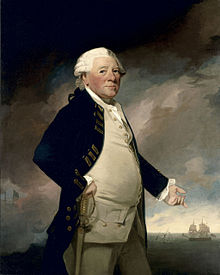Battle of Dogger Bank (1781)
[4] The opening of hostilities with the Dutch meant that Britain's trade with countries on the Baltic Sea—where key supplies of lumber for naval construction were purchased—was potentially at risk, and that the British had to increase protection of their shipping in the North Sea.
On 1 August 1781, Admiral Johan Zoutman led a fleet of some 70 merchantmen from the Texel, protected by seven ships of the line as well as a number of frigates and smaller armed vessels.
Admiral Sir Hyde Parker was accompanying a convoy of ships from the Baltic when he spotted the sails of the Dutch fleet at 04:00 on the morning of 5 August.
He immediately despatched his convoy toward the English coast, and ordered his line to give chase rather than prepare for battle.
With a calm sea and a breeze from the north-east, Zoutman manoeuvred his line onto a port tack, heading south-east by east, and awaited Parker, who held the weather gage.
The British fleet closed, raggedly at first due to the poor condition of some of the ships, into a line of battle abreast in accordance with the signal raised at 06:10.
[7]: 48 When Parker raised the battle flag shortly before 08:00, for close action, the British fleet moved closer.
Surprisingly, the Dutch ships did not fire as the British approached until the two fleets were about half a musket shot apart.
In addition, Dutch merchant trade remained crippled by the constant capture of their merchantmen by British privateers.

